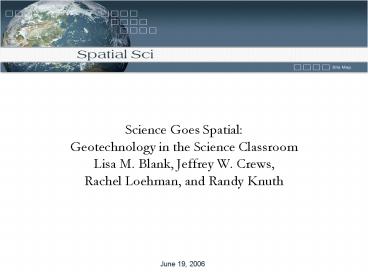Science Goes Spatial: - PowerPoint PPT Presentation
1 / 15
Title: Science Goes Spatial:
1
- Science Goes Spatial
- Geotechnology in the Science Classroom
- Lisa M. Blank, Jeffrey W. Crews,
- Rachel Loehman, and Randy Knuth
2
Spatial Thinking
3
(No Transcript)
4
- Spatial thinking must be recognized as a
fundamental part of K-12 education and as an
integrator and a facilitator for problem solving
across the curriculum. With advances in computing
technologies and the increasing availability of
geospatial data, spatial thinking will play a
significant role in the information- based
economy of the 21st-century. Using appropriately
designed support systems tailored to the K-12
context, spatial thinking can be taught formally
to all students. A geographic information system
(GIS) offers one example of a high-technology
support system that can enable students and
teachers to practice and apply spatial thinking
in many areas of the curriculum (National
Research Council, 2005).
5
- In the recently released proceedings from the
National Science Teachers Association
(http//science.nsta.org/enewsletter/lmr.pdf), an
alarming trend was noted - . . . new and emerging technologies, which help
shape the future of science and discovery, are
making their way into the K-12 curriculum in a
belated or back-door fashion, if at all.
Technologies that are developed for business
applications are being adapted, at best, in a
makeshift fashion for educational use. . . For
the US to maintain its leadership position in the
new information-based world economy . . .
emerging technologies with science education
potential must be made available to students and
teachers.
6
- Overall GTEC Goal
- Contribute to a national model that improves the
teaching and learning of science in grades 5-12
using geotechnologies.
7
- Earth Observing Systems Education Project (EOS)
- GIS4MT
- 235 participating schools
- Introductory GIS trainings across Montana
- Obstacles to full implementation of GIS
- Onsite Support
- Data sets
8
(No Transcript)
9
- GTEC Project Goals
- Increase student interest in science, technology
and geotechnologies - Develop student mastery in using geospatial
technologies when solving real-world
interdisciplinary problems - Prepare students for careers in geospatial
technologies - Increase teacher comfort in use of
geotechnologies in classroom - Help teachers infuse geotechnologies into
classroom instruction - Build a national model for introducing geospatial
technology to improve 5-12 science teaching and
learning.
10
- GTEC is a teacher training model that
sustains the use of geospatial technology within
Montana classrooms, positions Montana science
classrooms as leaders in geotechnology education,
and transfers to other sites across the country. - Develop geotechnology educator leadership teams
- Generate spatial data sets that are appropriate
for use with school-aged audiences and aligned
with national science education standards - Establish a system of support for dissemination
of geospatial applications in the 5-12 science
classroom including interactive website, help
desk and bi-annual video conferencing - Found a statewide geospatial technology
competition - Disseminate a national model for introducing
geospatial technology to improve 5-12 science
teaching and learning
11
(No Transcript)
12
- GTEC Outcomes
- Explore geospatial resources being used by
research scientists across Montana - NTSG Faith Ann Heinsch and Rachel Loehman
- DBS Bill Granath
- FLBS Niels Maumenee
- Precision Agriculture Bob Rumney
- Share work with school district via an in-service
workshop
13
- Create geospatial module using GIS data
- ESRI Template
- Global Climate Change
- Two week module
- Implement geospatial module in your classroom
during the 2006-2007 academic year - Video tape GIS lesson highlighting student use of
geospatial data set generated from GTEC summer
institute - Participate in pilot student GIS competition
spring 2007
14
- GTEC Support
- 2000 teacher stipend
- 500 classroom mini grant
- Four two-hour workshop sessions via video
conference - Weekly help desk support
- Graduate credit or OPI hours
15
- Geospatial Careers
- http//geospatialcareers.net/































